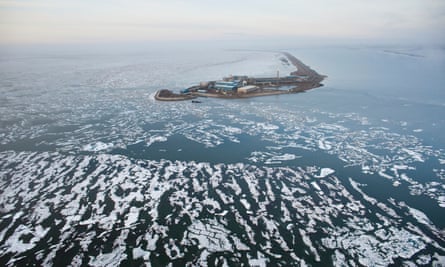Barack Obama has been forced to defend his decision to allow the hunt for oil in the last great wilderness of the Arctic, on the eve of an historic visit to Alaska intended to spur the fight against climate change.
The three-day tour – which will include a hike across a shrinking glacier and visits to coastal communities buffeted by sea-level rise and erosion – was intended to showcase the real-time effects of climate change.
But a defensive White House was forced to push back against campaigners who accuse Obama of undermining his environmental agenda by giving the go-ahead to Shell to drill for oil in the Chukchi Sea, only weeks after rolling out his signature climate change plan.
Obama, in his weekly address on Saturday, insisted there was no clash between his climate change agenda and Arctic drilling.
America was beginning to get off fossil fuels, he said. But Obama went on: “Our economy still has to rely on oil and gas. As long as that’s the case, I believe we should rely more on domestic production than on foreign imports.”
The challenges of protecting the Arctic from climate change as well as the risks of offshore drilling were both on full display on the eve of Obama’s visit.
Disappearing sea ice cover forced an estimated 6,000 walruses, mainly females and their young, to come to shore on a remote barrier island off the Chukchi Sea, US government officials said on Friday.
Meanwhile, Shell was forced to pause its drilling in the Chukchi and evacuate workers “because of extreme weather conditions”, a company spokesman said in an email.
Obama defended the drilling operation, saying: “We don’t rubber-stamp permits.”
The president had hoped to use his visit to showcase the changes unfolding in the Arctic, which is warming twice as fast as the rest of the world, the White House said.
“This is an issue that is very here and now,” Brian Deese, a senior White House advisor told a conference call with reporters on Friday. “Near and above the Arctic circle the impacts of climate change are particular pronounced and Americans are living with those impacts in real time.”
He said Obama would use the visit to draw public attention to those consequences: the retreat of sea ice, land loss due to melting permafrost and coastal erosion, increasingly severe storms and growing risk of wildfires.

The president will also highlight the risks to Alaska’s tiny coastal communities, some of which could be forced to relocate because of climate change. A number have already chosen to move but have no funds to do so.
But campaign groups said Obama was sabotaging his own mission by giving the go-ahead to Shell to hunt for oil.
“There is a very obvious contradiction between meaningful action to address climate change and continued exploration for remote and difficult hydrocarbon resources,” said Michael LeVine, Arctic campaigner for Oceana.
“Moving forward with exploiting Arctic oil and gas is inconsistent with the Administration’s stated goal and meaningful action on climate change.”
Credo, another campaign group, accused Obama of “self-defeating hypocrisy”.
Obama’s first stop on Monday will be a foreign ministers’ conference in Anchorage. The US will take over leadership of the eight-nation Arctic Council later this year.
After a visit to melting glaciers in the Kenai Fjords National park, Obama will visit the rural community of Dillingham, close to Bristol Bay, site of the world’s biggest natural salmon run. The president will also visit the town of Kotzebue, which is increasingly battered by Arctic storms because of coastal erosion and the retreat of sea ice cover.
The White House hoped the visit would help spur a global deal to fight climate change at an international conference in Paris at the end of the year. Negotiators will meet in Bonn next week to try to advance negotiations.
The president is also expected to promote his plan to cut carbon pollution from power plants by 32% below 2005 levels, and his expansion of protections to Alaska wilderness areas.
Drawing attention to the changes in the polar regions could help Obama win over public support, said Marilyn Heiman, director of the US Arctic program for Pew Charitable trusts.

“He is shining a light on the Arctic and the impacts of climate change on the Arctic and the impact a warming Arctic has on the rest of planet,” she said. “There is no better way for the world or United States to hear about that then have the president visit.”
But campaigners criticised Obama for opening up the Arctic to oil companies.
The Arctic Circle is the last great untapped reserve of oil and gas – containing up to 30% of the world’s undiscovered gas and 13% of oil, according to the US Geological Survey. It is also a home for indigenous people and endangered wildlife who have co-existed for thousands of years.
Giving the go-ahead to Shell to drill two exploratory wells in the harsh and unforgiving conditions puts the Arctic at risk of a spill, campaign groups argue.
And tapping into that waiting bonanza of oil and gas would also trigger catastrophic climate change.
Rick Steiner, a marine biologist who was involved in the Exxon Valdez clean-up in the 1980s, said: “On climate change Obama has been good but not good enough.”
Comments (…)
Sign in or create your Guardian account to join the discussion